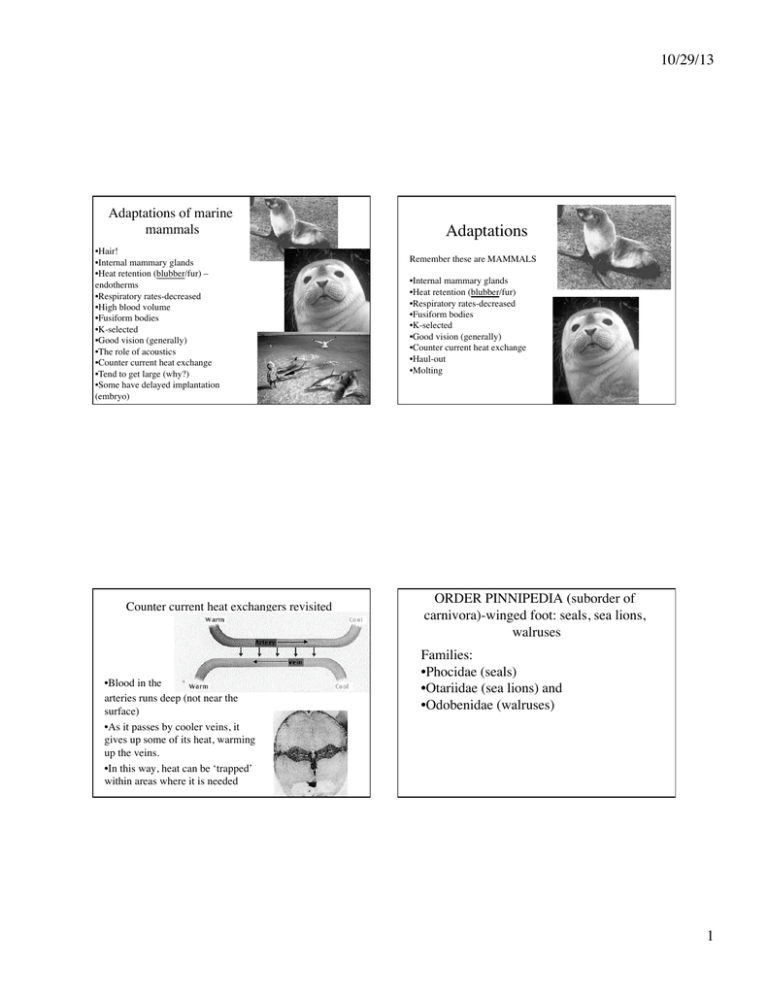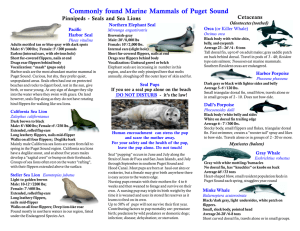Document 13036534
advertisement

10/29/13 Adaptations of marine mammals • Hair! • Internal mammary glands • Heat retention (blubber/fur) – endotherms • Respiratory rates-decreased • High blood volume • Fusiform bodies • K-selected • Good vision (generally) • The role of acoustics • Counter current heat exchange • Tend to get large (why?) • Some have delayed implantation (embryo) Counter current heat exchangers revisited • Blood in the arteries runs deep (not near the surface) • As it passes by cooler veins, it gives up some of its heat, warming up the veins. • In this way, heat can be ‘trapped’ within areas where it is needed Adaptations Remember these are MAMMALS • Internal mammary glands • Heat retention (blubber/fur) • Respiratory rates-decreased • Fusiform bodies • K-selected • Good vision (generally) • Counter current heat exchange • Haul-out • Molting ORDER PINNIPEDIA (suborder of carnivora)-winged foot: seals, sea lions, walruses Families: • Phocidae (seals) • Otariidae (sea lions) and • Odobenidae (walruses) 1 10/29/13 Phocidae • Internal testes • Hind flipper propulsion • No external ears • Can t really walk on fore flippers like sea lions can • Deeper divers • Squid eaters (primarily) Elephant seals • Beach breeders territorial • Polygynous – with dominant males • Males can weigh up to 5500 lbs (8500 in the S. Elephant seal!) and be 15-20 feet long • Females are much smaller – 10 feet and 1500-2000 lbs • Sexual dimorphism Elephant seals can dive to extreme depths – up to 1500 meters! (over 3,000 feet), and hold their breath for 20-60 minutes. They have large blood volume, use myoglobin to carry oxygen, and can lower their heart rate to less than 9 beats per minute Otariidae: sea lions Breeding - colonies • Long fore-flippers • Can walk and maneuver well on their fore flippers • Swim underwater with fore flippers • External ears (pinnae) • External testes • More recently evolved Sea Lions spend more time with their young • Fish eaters 2 10/29/13 Breeding - ice Seals wean early 1-4 weeks after birth Parental investment is high though – milk can more than 50% milkfat Ice breeders tend to be monogamous, and have far less sexual dimorphism. This is in part because ice territories are more difficult to defend, unlike beach territories There are of course always exceptions… Odobenidae: walrus • Internal testes • No external ear flaps • Flippers like a sea lion (large fore flippers) Hooded seals exhibit sexual dimorphism – the males have a secondary sexual characteristic to attract females • Use their large teeth (tusks) to dredge the bottom for molluscs and other invertebrates 3 10/29/13 Other marine mammals Mustelidae Sea Otters: Enhydra Lutris Nereis Returned to the sea about 15 MYA Feeding: Feed on a variety of invertebrates (CA) Play an important role maintaining the ecology of kelp forests Mothers pass food preference to her offspring Tool users! Keystone predators Mother stays with pup for about 1 yr. Gives birth every 1-2 years Reproduction: Males are sexually mature at about 5-6 yrs Females 4-8 yrs 8 month gestation Delayed implantation Pups can swim at about 4-6 wks Can forage on their own at about 6 months 4 10/29/13 This year s pup counts were the lowest since 2003 Ursus maritimus Polar Bears Ursus maritimus They live in the Arctic. They hunt seals in sea ice leads Status – threatened, but data deficient. ~20,000? Closely related to the brown bear (Grizzly) 5 10/29/13 Males – up to 1200 lbs! Females up to 600 lbs Cubs (twins) are born in Nov-Dec Emerge from the Den in April! 31% milkfat 2.5 year dependency 6





